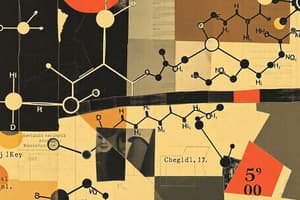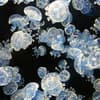Podcast
Questions and Answers
What is produced when benzene reacts with the NO2+ electrophile at appropriate conditions?
What is produced when benzene reacts with the NO2+ electrophile at appropriate conditions?
- Aromatic amines (correct)
- Alkylbenzene
- Benzene sulfonic acid
- Phenylacetone
What happens to the hydrogen ion during the reaction of benzene with the NO2+ electrophile?
What happens to the hydrogen ion during the reaction of benzene with the NO2+ electrophile?
- It becomes a part of the electrophile.
- It is removed from the benzene ring. (correct)
- It is retained in the final product.
- It is converted to acyl chloride.
What temperature is typically required for mono-substitution to occur in the reaction of benzene with the NO2+ electrophile?
What temperature is typically required for mono-substitution to occur in the reaction of benzene with the NO2+ electrophile?
- 150°C
- 25°C
- 55°C (correct)
- 100°C
Which catalyst is necessary for Friedel-Crafts acylation with benzene?
Which catalyst is necessary for Friedel-Crafts acylation with benzene?
What type of product is formed as a result of the Friedel-Crafts acylation of benzene?
What type of product is formed as a result of the Friedel-Crafts acylation of benzene?
In the context of electrophilic aromatic substitution, what does the NO2+ ion serve as?
In the context of electrophilic aromatic substitution, what does the NO2+ ion serve as?
What is a common use for the products formed from reactions involving aromatic amines and phenylketones?
What is a common use for the products formed from reactions involving aromatic amines and phenylketones?
What is the role of the hydrogen ion generated in Friedel-Crafts acylation after reacting with AlCl4-?
What is the role of the hydrogen ion generated in Friedel-Crafts acylation after reacting with AlCl4-?
What type of bonding characterizes benzene?
What type of bonding characterizes benzene?
What is the correct enthalpy change of hydrogenation for benzene?
What is the correct enthalpy change of hydrogenation for benzene?
Why do arenes have high melting points?
Why do arenes have high melting points?
What makes benzene susceptible to electrophilic attack?
What makes benzene susceptible to electrophilic attack?
Which of the following describes the structure of benzene?
Which of the following describes the structure of benzene?
Why do arenes typically have low boiling points?
Why do arenes typically have low boiling points?
What happens to the benzene ring during electrophilic substitution?
What happens to the benzene ring during electrophilic substitution?
Which of the following statements is NOT true about benzene?
Which of the following statements is NOT true about benzene?
Flashcards are hidden until you start studying
Study Notes
Aromatic Chemistry
- Aromatic compounds are commonly used in industries for the production of dyes, pharmaceuticals, and explosives.
- Benzene is an aromatic compound with a ring of six carbon atoms, six hydrogen atoms, and six delocalized electrons.
- The bonding in benzene is characterized by intermediate bond lengths between single and double bonds, resulting from the delocalization of electrons from carbon's p-orbitals.
- Benzene's high stability is attributed to its delocalized ring structure.
- Arenes, compounds containing benzene as a structural component, exhibit high melting points due to the stability of their delocalized rings.
- Arenes, due to their non-polarity, have low boiling points and often display poor solubility in water.
- The delocalized electron ring in benzene is susceptible to attack by electrophiles, leading to electrophilic substitution.
Electrophilic Substitution
- The delocalised ring of benzene acts as an electron-rich area, making it vulnerable to electrophilic attack.
- Electrophilic substitution reactions involve the partial destruction and subsequent restoration of the benzene ring.
Nitrobenzene
- Nitration involves the substitution of NO2+ electrophile onto the benzene ring. It is a major reaction that occurs with concentrated nitric acid (HNO3) and concentrated sulfuric acid (H2SO4).
- The NO2+ electrophile is produced as a reactive intermediate during the reaction.
- This reaction is a mono-substitution at 55°C resulting in the production of a single NO2+ electrophile.
- Multiple substitutions can occur at temperatures exceeding 55°C.
Friedel-Crafts Acylation
- The delocalised electron ring in benzene, acting as a nucleophile, undergoes attack by acyl chlorides. This is known as Friedel-Crafts acylation.
- An intermediate is created from acyl chloride and a catalytic aluminum chloride.
- The reactive intermediate is attacked by the benzene ring.
- The removed H+ ion reacts with the AlCl4- ion to regenerate aluminum chloride, signifying its catalytic role.
- The phenylketone is the final product.
- The term "phenyl group" refers to the benzene group.
Studying That Suits You
Use AI to generate personalized quizzes and flashcards to suit your learning preferences.





